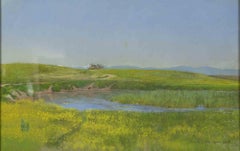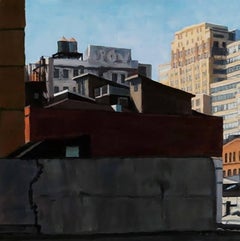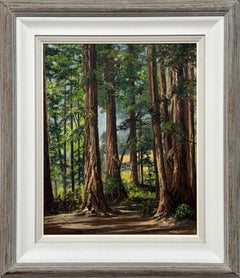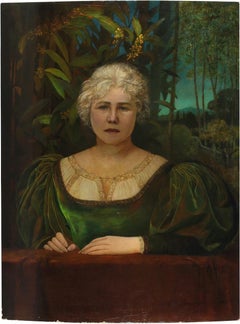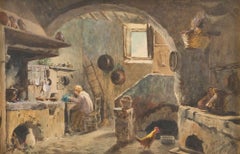Edoardo Gioja Art
to
1
Overall Width
to
Overall Height
to
1
1
1
1
1
1
1
1
1
1
1
1
1
1
1
9,989
2,754
1,378
1,375
1
1
Artist: Edoardo Gioja
Roman Countryside - Mixed Media by E. Gioja - 1908
By Edoardo Gioja
Located in Roma, IT
Roman Countryside is a modern artwork realized in 1908 by Edoardo Gioja.
Mixed media on wood panel. Hand signed and dated on the lower right margin.
Includes frame.
Edoardo Gioja (Rome, 1862 - Rome, 1937), an Italian painter and artist. He treated the decoration and portrait with Pre-Raphaelite taste. Influenced by Nino Costa, he repudiated genre painting by reproducing marines, countries, plants, animals and painted and drew with simplicity and with very effective results. He decorated several rooms in London and prepared cartoons for stained glass...
Category
Early 1900s Modern Edoardo Gioja Art
Materials
Tempera, Wood Panel
Related Items
City Side (Modern Cityscape Oil Painting of Brooklyn Rooftops)
By Patty Neal
Located in Hudson, NY
oil paint on panel
12 x 12 inches
This contemporary cityscape oil painting is painted on wood panel in a realistic style. The scene is of a Brooklyn skyline where old water towers...
Category
2010s Modern Edoardo Gioja Art
Materials
Oil, Wood Panel
Vintage Oil Landscape Art of Redwood Forest California by 20th Century Artist
Located in Preston, GB
Vintage Oil Landscape Art of Redwood National Park Forest in California by 20th Century Artist, Tobias Everet Spence
Art measures 14 x 17 inches
Frame measures 21 x 24 inches
Th...
Category
1950s Modern Edoardo Gioja Art
Materials
Canvas, Oil, Wood, Paint, Wood Panel
$1,977
H 24 in W 21 in D 2 in
Rooftops Power Lines, Five & Diamond: Abstract Cityscape Painting of Hudson NY
By Ricardo Mulero
Located in Hudson, NY
Abstract cityscape painting of Hudson, NY rooftops with accents of pink, magenta, green, yellow and teal
"Rooftops Power Lines and Five & Diamond," by Hudson, NY based artist, Ricardo Mulero
12 x 6 inch oil on wood panel, Painted in 2021
Excellent condition, ready to hang as is
Signed, lower left
Ricardo Mulero is fascinated with capturing the brilliance of light and the contrast of natural beauty with utilitarian landscapes. Here, he abstracted the city skyline of Hudson, NY. Buildings and rooftops in shades of magenta, teal, and green are segmented in the foreground and cropped with black power lines. A soft yellow sky is layered with thin strokes of gesturally applied pale blue paint, furthering abstracting the city landscape. The piece is in excellent condition and ready to hang as is. The sides are painted a very dark, warm magenta so framing is not necessary.
About the Artist:
Growing up in Puerto Rico, I observed how people and nature could co-exist in harmony. Today, that principle guides my design and artistic work. My paintings are expressions that draw upon my life experiences, traditions, and surroundings. These unique environments inspire my oil paintings: Puerto Rico, where I grew up, New York City, Fire Island Pines...
Category
2010s Modern Edoardo Gioja Art
Materials
Oil, Wood Panel
$850
H 12 in W 6 in D 2 in
Only Pay if We Win (Funny, Billboard, Legend, Iconic, ~26% OFF LIST PRICE)
Located in Kansas City, MO
Annieo Klaas
Only Pay if We Win (Yester Oaks and Montlimar)
2024
Oil on Wood Panel
12 x 12 inches (30.48 x 30.48 cm)
Signed verso
COA provided
*Ready to hang
Annieo Klaas’s Alabama...
Category
2010s Modern Edoardo Gioja Art
Materials
Oil, Wood Panel
$288 Sale Price
25% Off
H 12 in W 12 in D 1.5 in
Study for a Fish at Sea with Three Flags-Ink, egg-tempera and gold leaf on panel
By Konstantinos Papamichalopoulos
Located in Dallas, TX
Konstantinos Papamichalopoulos was born in Athens, Greece in 1975. He studied painting and printmaking at the Athens School of Fine Arts, where he also received a postgraduate degree...
Category
2010s Contemporary Edoardo Gioja Art
Materials
Gold Leaf
$1,320 Sale Price
20% Off
H 7.88 in W 15.75 in D 1.19 in
Hank Aaron Loop (Skyscape, Baseball, Icon, Legend)
Located in Kansas City, MO
Annieo Klaas
Hank Aaron Loop (Skyscape, Baseball, Icon, Legend)
2024
Oil on Wood Panel
8 x 8 inches (20.32 x 20.32 cm)
Signed lower left
COA provided
*Ready to hang
Annieo Klaas’s ...
Category
2010s Modern Edoardo Gioja Art
Materials
Oil, Wood Panel
The Lonely Road by William Charles Palmer
Located in Hudson, NY
The Lonely Road (1940)
Tempera on panel
12" x 16"
19 1/2" x 23 1/2" x 1 1/2" framed
Hand-signed "Palmer '40" lower center.
Provenance: Midtown Galleries, New York, NY (labels verso...
Category
Mid-20th Century American Modern Edoardo Gioja Art
Materials
Tempera, Panel
Black & White Americana Painting of Ranchito Motel on Route 66 New Mexico USA
By Angela Wakefield
Located in Preston, GB
Panoramic Black & White Painting of the legendary Ranchito Motel on Route 66, New Mexico, USA.
A unique original from leading British Cityscape Artist, Angela Wakefield.
Art measures 24 x 12 inches
Frame measures 28.8 x 16.8 inches
Angela Wakefield has twice been on the front cover of ‘Art of England’ and featured in ARTnews, attracting international attention and critical acclaim with her urban landscape paintings of New York, London & the North of England. The style of painting has been described as ‘contemporary realism’, and is often favourably compared with Edward Hopper by collectors and art critics. Angela’s work is held in private collections in Europe and the USA, including the British Royal Family. Her admirers include leading figures in international business...
Category
2010s Modern Edoardo Gioja Art
Materials
Gesso, Paint, Oil, Acrylic, Wood Panel, Board
$2,599 Sale Price
41% Off
H 16.8 in W 28.8 in D 1.75 in
Sky is the Limit (Oil Painting, Impasto, Impressionism, Colorful, Pastel, Cool)
Located in Kansas City, MO
Genevieve Hamel
Sky is the Limit
Oil on Wood Panel
Year: 2024
Size: 36 x 18 x 1.625 inches
Signed by hand
COA provided
*wired and ready to hang
Genevieve Hamel’s passions for desi...
Category
2010s Modern Edoardo Gioja Art
Materials
Oil, Wood Panel
Genevieve HamelSky is the Limit (Oil Painting, Impasto, Impressionism, Colorful, Pastel, Cool), 2024
$1,666 Sale Price
24% Off
H 36 in W 18 in D 1.625 in
La Beauté du Diable The Devil's Beauty Surrealism Conteporary Landscape Creature
By Gérard Willemenot
Located in Utrecht, NL
La Beauté du Diable The Devil's Beauty Surrealism Conteporary Landscape Creature
Gérard Willemenot was born on February 11, 1943.
World War II and his father's deportation to Mautha...
Category
21st Century and Contemporary Surrealist Edoardo Gioja Art
Materials
Tempera, Panel
$4,769
H 9.45 in Dm 9.45 in
Giant At Sea, Asian Inspired Painting with Samurai, Ink, egg-tempera, gold leaf
By Konstantinos Papamichalopoulos
Located in Dallas, TX
"Giant At Sea" is an Asian Inspired Painting with a colorful Samurai and sailing boats in the ocean, with lots of white waves. The piece is created using ink, egg-tempera, and a gold...
Category
2010s Contemporary Edoardo Gioja Art
Materials
Gold Leaf
$4,000 Sale Price
20% Off
H 25.2 in W 28.75 in D 1.19 in
Dreamland (BBQ, Bar-B-Que, Wings, Billboard, Legend, Iconic, ~26% OFF)
Located in Kansas City, MO
Annieo Klaas
Dreamland
2024
Oil on Wood Panel
8 x 8 inches (20.32 x 20.32 cm)
Signed verso
COA provided
*Ready to hang
Annieo Klaas’s Alabama Billboard Series is a whimsical explor...
Category
2010s Modern Edoardo Gioja Art
Materials
Oil, Wood Panel
$222 Sale Price
25% Off
H 8 in W 8 in D 1.5 in
Previously Available Items
Woman in the Nature - Oil on Panel by E. Gioja - Early 1900
By Edoardo Gioja
Located in Roma, IT
Woman in the Nature is an original modern artwork realized by the Italian modern artist Edoardo Gioja in the first years of the XX Century.
Original oil painting on panel.
Hand-signed on the lower right corner.
Mint conditions.
Interesting painting on canvas characterized by a naive taste. The figure of the woman wears medieval clothes and the tissues are treated in an extremely refined way. The figure is immerged in a luxuriant and verdant nature. This work has been realized by Edoardo Gioia (Rome, 1862 - Rome, 1937), an Italian painter and artist. He treated the decoration and portrait with Pre-Raphaelite taste. Influenced by Nino Costa, he repudiated genre painting by reproducing marines, countries, plants, animals and painted and drew with simplicity and with very effective results. He decorated several rooms in London and prepared cartoons for stained glass...
Category
Early 20th Century Edoardo Gioja Art
Materials
Oil, Panel
H 36.03 in W 26.78 in D 1.19 in
Peasants' House - Watercolor on Paper by E. Gioja -
By Edoardo Gioja
Located in Roma, IT
Peasants' House is an original moder artwork realized by Edoardo Gioja in 1874.
Original watercolor on paper.
Hand-signed and dated "Monte Porzio, 28 agosto 1874" on the lower rig...
Category
1870s Edoardo Gioja Art
Materials
Watercolor
Edoardo Gioja art for sale on 1stDibs.
Find a wide variety of authentic Edoardo Gioja art available for sale on 1stDibs. You can also browse by medium to find art by Edoardo Gioja in paint, watercolor, tempera and more. Much of the original work by this artist or collective was created during the early 1900s and is mostly associated with the modern style. Not every interior allows for large Edoardo Gioja art, so small editions measuring 14 inches across are available. Customers who are interested in this artist might also find the work of Alfonso Pragliola, Bruno Conte, and Antonio Donghi. Edoardo Gioja art prices can differ depending upon medium, time period and other attributes. On 1stDibs, the price for these items starts at $1,114 and tops out at $2,670, while the average work can sell for $2,670.
